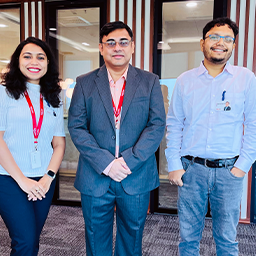

New Rakuten Pay Terminal Project
A payment terminal designed to cater to both consumers and retailers' diverse needs – promising to revolutionize our everyday lives
Cashless payments in Japan account for approximately one-third of total payments*¹, a proportion that has increased in recent years. Compared to other countries worldwide, Japan continues to uphold the notion that “cash is king.” On the positive side, this presents a significant opportunity with a vast untapped market for cashless payments in Japan.
The tremendous diversity of cashless payment methods makes Japan a unique and challenging market. Consumers are not limited to only credit and debit cards; they can also use code payment apps like Rakuten Pay, as well as e-money such as prepaid transportation cards. This vast array of payment options makes it challenging for retailers to accommodate all payment types without overcrowding their retail space with multiple scanners, card readers, receipt printers and other payment devices.
This is the challenge Rakuten Payment sought to solve – by creating an all-in-one payment terminal that is compact and mobile, capable of supporting all existing payment methods, ideally with a single, contactless tap. In our conversation with Brad and Hiko, two application engineers integral to the project, they shared insights into their contributions, focusing on the backend and frontend aspects, respectively.
MEMBER

Hiko
Applications Engineer – frontend

Brad
Applications Engineer – backend
Removing barriers and enhancing convenience for consumers and retailers
Rakuten Pay was first launched in 2012, primarily targeting small and medium-sized businesses, to enable easy in-store payments at a lowcost using consumers’ mobile devices. The Rakuten Pay app was introduced in 2016, and it was in anticipation of the continued growth in cashless payments that the company launched the Rakuten Pay Terminal project to develop a hand-held mobile device that would give other retailers access to Rakuten’s payment app.
Brad says,
We wanted to make the payment experience as fluid as possible for the merchant and shopper. If payment were a cumbersome experience, it would make conducting business harder for everyone. As such, we wanted to change how payments were made and give vendors more options, making transactions easier to process and handle.

Brad
Hiko adds,
We aimed to create a super-compact, super-convenient device that would replace old terminals, where card readers and receipt printers were separate. We wanted to create a device that could accept every payment available in Japan.

Hiko

Accelerating development without compromising on security or stability
Recognizing the fast pace of change in the cashless payment sector and the tremendous potential for expanding economic opportunities through cashless payments, the team made a swift start on development. Within a span of three months, they initiated the functionality and design processes.
Once the basic design was completed, a critical element in the development process was testing and ironing out issues. New features needed to work without impacting existing functions, as existing payment and transaction-related codes had been migrated into the project and coupled with new features. Given that this was a terminal planned for nationwide deployment, it was imperative that it worked smoothly, quickly and without any glitches that would negatively impact the payment experience.
On the technical front, it was also crucial to ensure a secure pairing of two devices using shared data while maintaining stable communication. To address this, the backend development team proposed the implementation of a high-speed shared data source to facilitate communication between the devices. Additionally, they recommended bidirectional streaming, enabling the retailer and server to continuously exchange multiple messages. Sustaining constant resource availability posed a key challenge for any high-performance system, ensuring uninterrupted interaction between terminals without potential disruptions that could lead to system crashes. The team conducted thorough testing using mockups to identify and resolve issues before successfully deploying the terminals, which are now operational in stores across Japan.
Security was another concern. Not only was it necessary to ensure uninterrupted bidirectional streaming, but it was also crucial to prevent interference between the two devices during payment transactions.
The system’s standout feature lies in its transaction speed. In the future, contactless payments will progressively become the norm because they offer a faster settlement process compared to inserting a card into a terminal. While the time difference between tapping and inserting a card may only be a few seconds, these extra seconds add up in a busy business environment, causing bottlenecks and delays. A simple tap to complete payment is a method that works for everyone of all ages.

The transformative effect of cashless payments
The development of the Rakuten Pay Terminal was both quick and comprehensive. It is now up and running throughout Japan and continues to evolve, with more features being developed and integrated into the terminal.
Brad says,
In the initial development phase, some things may have been technically possible but were not quite ready. We are looking to build further features and integrate more technology.

Brad
Hiko is enthusiastic about the potential of the new device.
This project empowers our impact on the cashless industry. No matter the merchant’s size, they can adopt cashless technology in their business. The device is small, hand-held and mobile, so merchants can use it anywhere. This is an awesome product that can change our everyday lives.

Hiko
Listening to Brad and Hiko talk, it is easy to imagine the advantages Rakuten Pay Terminal can bring to businesses and the community. From micro businesses run by single owners in rural areas to established retail chains in urban centers, the terminal is adaptable to any environment, indoors or outdoors. The key to its growth and expansion lies in its ease of use, which encourages people to adopt the Rakuten Pay Terminal, further increasing uptake.
The rewards and satisfaction of working on a major, nationwide project
The Rakuten Payment Terminal project not only resulted in a tangible new service but also brought its own rewards for team members. Brad highlights the satisfaction he derived from building a system used nationwide, which also provided learning opportunities through the use of new technologies and programming languages.
Hiko commented that the project provided an intriguing insight into the intricacies of cashless payments. In a society where many of us tap or scan a terminal to make payments, seldom do we ponder the intricate processes unfolding in that instantaneous contactless payment moment. Hiko notes that the project provided the opportunity to understand the backend processes involved in cashless payments.
This project involved every one of Rakuten’s Five Principles for Success*², but two stood out the most. “Speed!! Speed!! Speed!!” was evident in the swift completion of the project, while “Always Improve, Always Advance” still underpins the project’s ongoing development and the constant addition of new features.
Contemplating the future landscape of cashless payments in Japan, Brad considers whether consumers will ultimately relinquish their preference for cash payments. He remarks, “It depends on the different options and incentives. Our role is to eliminate the barriers as much as possible and empower consumers to make their own choices.
The cashless payments sector in Japan holds immense possibilities for expansion. With the development of the Rakuten Pay Terminal, Rakuten is well-positioned to take a leading position in this dynamic and rapidly advancing industry.
1 METI Ministry of Economy, Trade and Industry
2 About Us:
https://global.rakuten.com/corp/about/philosophy/principle/
*This article is based on the information at the time of the interview.

OTHER PROJECTS


Rakuten Optimism

Rakuten Optimism
Over 100,000 attend the first offline Rakuten Optimism event in 4 years: A testament to our “One Team” spirit


Initiatives Towards Carbon Neutrality

Initiatives Towards Carbon Neutrality
Uniting business units: The key to carbon neutrality success


Leveraging the Power of AI in the Treatment of Cancer

Leveraging the Power of AI in the Treatment of Cancer
A project that seeks to bridge disciplines and harness the potential of a novel therapy, aiming to bring hope to patients around the world


A New and Unprecedented Business Scheme

A New and Unprecedented Business Scheme
Rakuten Super Mini Job team provides unique value offering
Fostering win-win-win relationships through new service
RECRUITING INFORMATION
Business Positions
For those who want to deepen their understanding of the entire Rakuten Group and aim for versatile career development.
- Comprehensive Business Specialty Hiring Track
- Corporate Specialty Hiring Track
- FinTech Specialty Hiring Track
- Design Specialty Hiring Track
- Marketing Specialty Hiring Track
- Comprehensive Business Specialty Hiring Track
- Corporate Specialty Hiring Track
- FinTech Specialty Hiring Track
- Design Specialty Hiring Track
- Marketing Specialty Hiring Track
Engineer Positions
For those who aspire to become world-class engineers.
- Applications Engineer
- Infrastructure Engineer
- Data Scientist / Researcher
- Security Engineer
- Information Security / Privacy Governance Specialist
- Technology Management
- Product Management
- Development Support(Q&A, etc.)
- Applications Engineer
- Infrastructure Engineer
- Data Scientist / Researcher
- Security Engineer
- Information Security / Privacy Governance Specialist
- Technology Management
- Product Management
- Development Support(Q&A, etc.)
